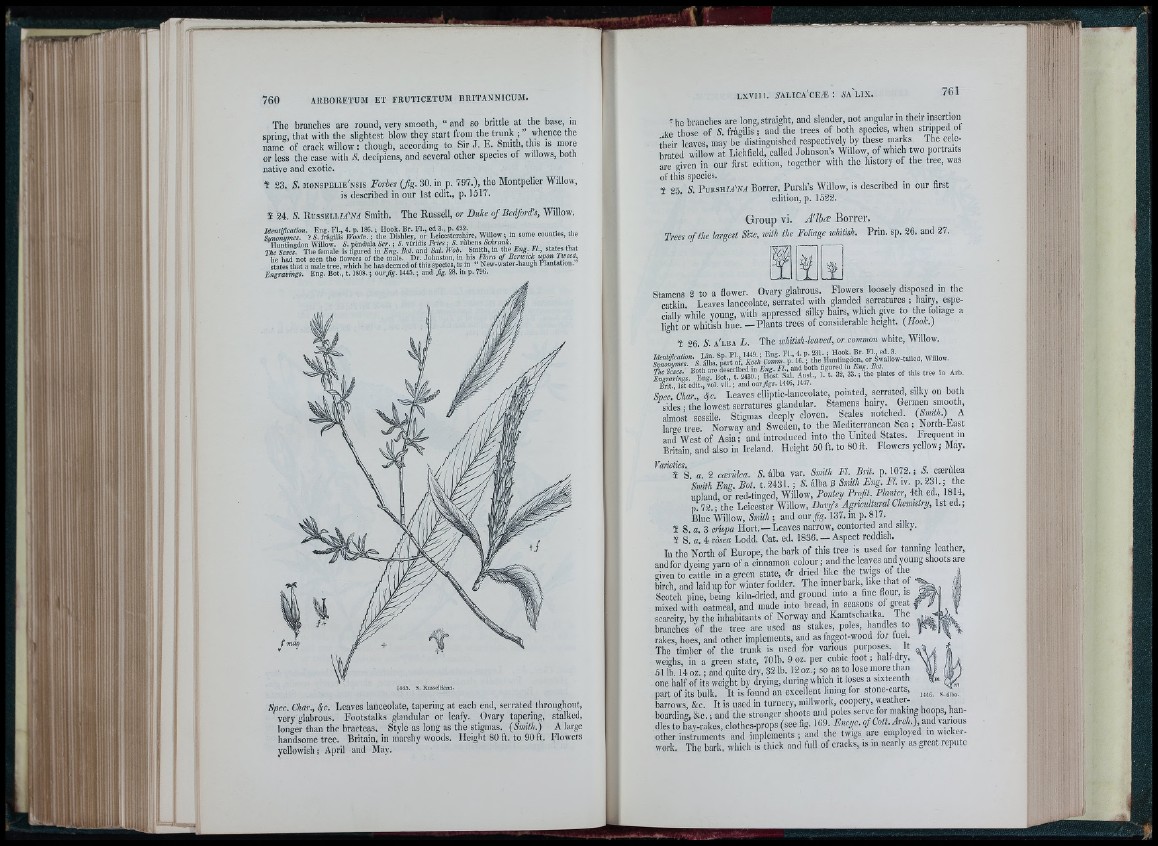
The branches are round, very smooth, “ and so brittle at the base, in
spring, that with the slightest blow they start from the trunk ; ’ whence the
name of crack willow : thouch, according to Sir J. E. Smith, this is more
or less the case with S. decipiens, and several other species of willows, both
native and exotic.
¥ 23. S. monspelie'nsis Forbes (Jig. 30. in p. 797.), the Montpelier Willow,
is described in our 1st edit., p. 1517.
¥ 24. S. R v s sé íl ia ^na Smith. The Russell, or Duke o f Bedford’s, Willow.
Ideniification. Ene. F l., 4. p. 186.; Hook. Br. F!., ed 3., p. 422. _
Simonymes. ? S. frágilis Woodv. ; the Dishley, or Leicestershire, Wil ow ; m some counties, the
Huntingdon Willow. S. péndula Ser. ; S. viridis Fries \ S. rübens Schrank. .
The Sexes. The female is figured in Eng. Bot. and Sal. Wob. bmith, in the Eng. Fl., states that
he had not seen the flowers of the male. Dr. Johnston, in his Ftó»-« Berwick imon Tweed^^^
states that a male tree, which he has deemed of this species, is in New-water-haugh 1 lantation.
Engravings. Eng. Bot., t. 1808.; ourfig. 1445.; and fig. 28. In p. 796.
1-145. S . Russelliina.
Spec. Char., 4c. Leaves lanceolate, tapering at each end, sei rated throughout,
very glabrous. Footstalks glandular or leafy. Ovary tapering, stalked,
longer than the bracteas. Style as long as the stigmas. (Smith.) A large
handsome tree. Britain, in marshy woods. Height 80 ft. to 90 ft. Flowers
yellowish; April and May.
» he branches are long, straight, and slender, not angular m their insertion
.ke those of S. frágilis ; and the trees of both species, when stripped ot
their leaves, may be distinguished respectively by these m/k s. The cele-
hrited wilfow at Lichfield, called Johnson’s Willow, of which two portraits
ore given in our first edition, together with the history of the tree, was
of this species.
Y 25 S TvRsniANA Borrer, Pursh’s Willow, is described in our first
' ■ edition, p. 1522.
Trees of the
Group vi. A'lhce Borrer.
Size, with the Foliage whitish. Prin, sp. 26. and 27.
I J l i .
Stamens 2 to a flower. Ovary glabrous. Flowers loosely disposed in the
catkin L e a v e s lanceolate, serrated with glanded serratures; hairy,_ especially
Lhile young, with appressed silky hairs, which pve to the foliage a
light or whitish hue. — Plants trees oi considerable height. (Hook.)
Ï 26. S. a ' l b a L . The whitish-leaved, or common white. Willow.
Æ 3 3 .;U e pia.es of .his .ree h, Arh.
Brit., Is. edit., vol. vii. ; and o a r * s . 1446, 1447. ^
Spec Char 4c. Leaves elliptic-lanceolate, pointed, serrated, silky on both
sides ; th? lowest serratures glandular. Stamens hairy. Germen smooth
almost sessile. Stigmas deeply cloven. Scales notch/l. (Sm,l/i.) A
larae tree. Norway and Sweden, to the Mediterranean Sea ; North-East
and West of Asia; and introduced into the United States. Frequent in
Britain, and also in Ireland. Height SO ft. to 80 ft. Flowers yellow; May.
’"“’t e s . a. 2 coertdea. S. âlba var. Smiik Fl. Brit. p. 1072. ; S. cærùlea
Smith Fng. Bot. t. 2431. ; S. âlba ü Smith Fng. Ft. iv. p. the
upland, or red-tinged, Willow, Bonlcg Profit. Planter, 4th ed., 1814,
pf 72. ; the Leicester Willow, Davy's Agricultmal Chenmlry, 1st ed.;
Blue Willow, Smith ; and om fig . 137. in p. 817.
Ï s. «. 3 crispa Hort. —Leaves narrow, contorted and silky.
Ï S. «. 4 ròsea Lodd. Cat. ed. 1836. — Aspect reddish.
In the North of Europe, the bark of this tree is used for tanning leather,
and for dyeing yarn of a cinnamon colour ; and the leaves and young shoots ai e
given to battle in a green state, dr dried like the twigs of the _ ,1
birch, and laid up for winter fodder. The inner bark, like that of
Scotch pine, being kiln-dried, and ground into a fine flour, is
mixed with oatmeal, and made into bread, m seasons o( great.
scarcity, by the inhabitants of Norway and Kamtchatka. The
branches of the tree are used as stakes, poles, liandles to
rakes, hoes, and other implements, and as faggot-wood tor fuel.
The timber of the trunk is used for various purpora/ It
weighs, in a green state, 701b. 9 oz. per cubic foot; balt-dry,
51 lb. 14 oz. ; and quite dry, 32 lb. 12 oz. ; so as to lose more than
one half of its weight by drying, during which it loses a sixteenth
part of its bulk. It is found an excellent lining for stone-carts,
barrows, &c. I t i s u s e d i n turnery, millwork, coopery, weatherboardin?,
&c. ; and the stronger shoots and poles serve for making hoops, handles
to h%--rakes, clothes-props (see fig. 160 Encyc. oj Cott. Arch.), aqà various
other instruments and implements ; and the twigs are employed m wicker-
work. The bark, whicli is thick and full of cracks, is m nearly as gieat icputc